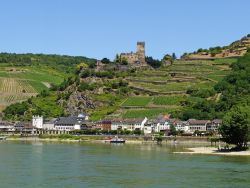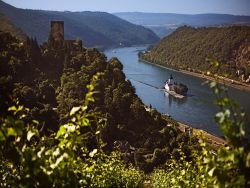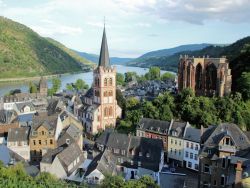|
Rhine River Valley After the Danube, the Rhine River is the second longest river in Western Europe. Split into four sections, High Rhine, Upper Rhine, Middle Rhine. and Lower Rhine, it is the Middle Rhine that is known specifically as “The Romantic Rhine”, with numerous castles, fortresses and wine making villages dotted along the river’s banks. The lower half of the Middle Rhine is famous for its ancient volcanic hills, and the upper half is designated as a UNESCO World Heritage Site with over 40 castles built during the Middle Ages. Picturesque little villages can be seen around each bend of the river, with their traditionally German half-timbered houses and Gothic church steeples, the area seems almost as if it were taken out of a fairytale. The river itself is full of cruising ships and rail lines which run along the banks. But high above the Rhine are the famous medieval castles. Most of them were originally built by noblemen who used the position of their lands to impose tolls on the passing ships along the river. One castle that stands out among the rest is the Marksburg Castle, above the town of Braubach. Out of the 40 castles found along the upper half of the Middle Rhine, Marksburg is the only one was never destroyed by an attack. Surprisingly this castle was used as a fortress for protection, rather than the typical summer residence for royal families. Unfortunately, over time many of the Rhine River Castles have wasted away, but in the 19th century a large number of them were restored, when European artists rediscovered the timeless beauty of the valley. The Lorelei is a steep slate rock on the right bank of the River Rhine near the village of Sankt Goarshausen. Over the centuries, it has inspired many tales: an old legend envisioned dwarfs living in caves in the rock. But today, it is most famous for the legend of Lorelei. In 1801, German author Clemens Brentano first told the story. In his poem, the beautiful Lore Lay, betrayed by her sweetheart, is accused of bewitching men and causing their death. Rather than sentence her to death, the bishop consigns her to a nunnery. On the way there, accompanied by three knights, she asks their permission to climb the Lorelei rock and view the Rhine once again. She does so and thinking that she sees her love in the Rhine, falls to her death. Afterwards the rocks echo her name. The inspiration for Brentano’s poem came from the myth of Ovid and Echo. In 1824, Heinrich Heine adapted Brentano's theme in his poem, "Die Lorelei". It describes the eponymous female as a siren who, sitting on the cliff above the Rhine and combing her golden hair, unwittingly distracted shipmen with her beauty and song, causing them to crash on the rocks. In 1837 Heine's lyrics were set to music by Friedrich Silcher in the song "Lorelei" that became well known in German-speaking lands. The Lorelei character, although originally imagined by Brentano, passed into German popular culture in the form described in the Heine–Silcher song and is commonly but mistakenly believed to have originated in an old folk tale. The French writer Guillaume Apollinaire took up the theme again in his poem "La Loreley", from the collection Alcools which is later cited in Symphony No. 14 of Dmitri Shostakovich. |
 |








